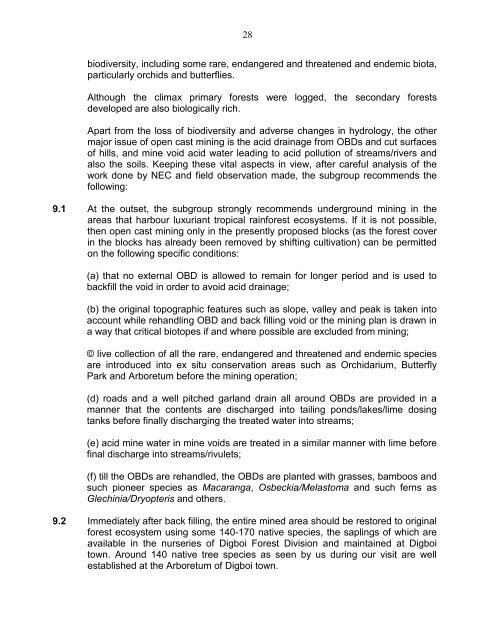MEETING HELD ON 18th-19th JUNE 2012 IN SCOPE COMPLE
MEETING HELD ON 18th-19th JUNE 2012 IN SCOPE COMPLE
MEETING HELD ON 18th-19th JUNE 2012 IN SCOPE COMPLE
- No tags were found...
Create successful ePaper yourself
Turn your PDF publications into a flip-book with our unique Google optimized e-Paper software.
28biodiversity, including some rare, endangered and threatened and endemic biota,particularly orchids and butterflies.Although the climax primary forests were logged, the secondary forestsdeveloped are also biologically rich.Apart from the loss of biodiversity and adverse changes in hydrology, the othermajor issue of open cast mining is the acid drainage from OBDs and cut surfacesof hills, and mine void acid water leading to acid pollution of streams/rivers andalso the soils. Keeping these vital aspects in view, after careful analysis of thework done by NEC and field observation made, the subgroup recommends thefollowing:9.1 At the outset, the subgroup strongly recommends underground mining in theareas that harbour luxuriant tropical rainforest ecosystems. If it is not possible,then open cast mining only in the presently proposed blocks (as the forest coverin the blocks has already been removed by shifting cultivation) can be permittedon the following specific conditions:(a) that no external OBD is allowed to remain for longer period and is used tobackfill the void in order to avoid acid drainage;(b) the original topographic features such as slope, valley and peak is taken intoaccount while rehandling OBD and back filling void or the mining plan is drawn ina way that critical biotopes if and where possible are excluded from mining;© live collection of all the rare, endangered and threatened and endemic speciesare introduced into ex situ conservation areas such as Orchidarium, ButterflyPark and Arboretum before the mining operation;(d) roads and a well pitched garland drain all around OBDs are provided in amanner that the contents are discharged into tailing ponds/lakes/lime dosingtanks before finally discharging the treated water into streams;(e) acid mine water in mine voids are treated in a similar manner with lime beforefinal discharge into streams/rivulets;(f) till the OBDs are rehandled, the OBDs are planted with grasses, bamboos andsuch pioneer species as Macaranga, Osbeckia/Melastoma and such ferns asGlechinia/Dryopteris and others.9.2 Immediately after back filling, the entire mined area should be restored to originalforest ecosystem using some 140-170 native species, the saplings of which areavailable in the nurseries of Digboi Forest Division and maintained at Digboitown. Around 140 native tree species as seen by us during our visit are wellestablished at the Arboretum of Digboi town.
















